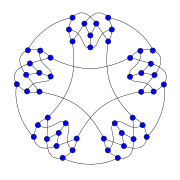Szekeres snark: Difference between revisions
Appearance
Content deleted Content added
m Robot - Removing category Graphs of diameter 7 per CFD at Wikipedia:Categories for discussion/Log/2018 July 21. |
#suggestededit-translate 1.0 Tags: Mobile edit Mobile app edit Android app edit |
||
| (3 intermediate revisions by 2 users not shown) | |||
| Line 1: | Line 1: | ||
{{Short description|Szekeres snark with 50 tops and 75 edges}}{{infobox graph |
|||
{{infobox graph |
|||
| name = Szekeres snark |
| name = Szekeres snark |
||
| image = [[Image:Szekeres snark alt.svg|220px]] |
| image = [[Image:Szekeres snark alt.svg|220px]] |
||
| Line 15: | Line 15: | ||
|book thickness=3|queue number=2}} |
|book thickness=3|queue number=2}} |
||
In the [[mathematics|mathematical]] field of [[graph theory]], the '''Szekeres snark''' is a [[snark (graph theory)|snark]] with 50 [[vertex (graph theory)|vertices]] and 75 edges.<ref>{{MathWorld|title=Szekeres Snark|urlname=SzekeresSnark}}</ref> It was the fifth known snark, discovered by [[George Szekeres]] in 1973.<ref>{{cite journal|author=Szekeres, G.|authorlink=George Szekeres|title=Polyhedral decompositions of cubic graphs|journal=Bull. Austral. Math. Soc.|volume=8|pages=367–387|year=1973|doi=10.1017/S0004972700042660|issue=3}}</ref> |
In the [[mathematics|mathematical]] field of [[graph theory]], the '''Szekeres snark''' is a [[snark (graph theory)|snark]] with 50 [[vertex (graph theory)|vertices]] and 75 edges.<ref>{{MathWorld|title=Szekeres Snark|urlname=SzekeresSnark}}</ref> It was the fifth known snark, discovered by [[George Szekeres]] in 1973.<ref>{{cite journal|author=Szekeres, G.|authorlink=George Szekeres|title=Polyhedral decompositions of cubic graphs|journal=Bull. Austral. Math. Soc.|volume=8|pages=367–387|year=1973|doi=10.1017/S0004972700042660|issue=3|doi-access=free}}</ref> |
||
As a snark, the Szekeres graph is a connected, bridgeless [[cubic graph]] with [[chromatic index]] equal to 4. The Szekeres snark is [[planar graph|non-planar]] and [[hamiltonian graph|non-hamiltonian]] but is [[hypohamiltonian graph|hypohamiltonian]].<ref>{{MathWorld|title=Hypohamiltonian Graph|urlname=HypohamiltonianGraph}}</ref> It has [[book thickness]] 3 and [[queue number]] 2.<ref>Wolz, Jessica; ''Engineering Linear Layouts with SAT.'' Master Thesis, University of Tübingen, 2018</ref> |
As a snark, the Szekeres graph is a connected, bridgeless [[cubic graph]] with [[chromatic index]] equal to 4. The Szekeres snark is [[planar graph|non-planar]] and [[hamiltonian graph|non-hamiltonian]] but is [[hypohamiltonian graph|hypohamiltonian]].<ref>{{MathWorld|title=Hypohamiltonian Graph|urlname=HypohamiltonianGraph}}</ref> It has [[book thickness]] 3 and [[queue number]] 2.<ref>Wolz, Jessica; ''Engineering Linear Layouts with SAT.'' Master Thesis, University of Tübingen, 2018</ref> |
||
| Line 34: | Line 34: | ||
[[Category:Regular graphs]] |
[[Category:Regular graphs]] |
||
[[Category:Graphs of radius 6]] |
|||
[[Category:Graphs of girth 5]] |
|||
{{combin-stub}} |
{{combin-stub}} |
||
Latest revision as of 14:15, 17 September 2021
| Szekeres snark | |
|---|---|
 The Szekeres snark | |
| Named after | George Szekeres |
| Vertices | 50 |
| Edges | 75 |
| Radius | 6 |
| Diameter | 7 |
| Girth | 5 |
| Automorphisms | 20 |
| Chromatic number | 3 |
| Chromatic index | 4 |
| Book thickness | 3 |
| Queue number | 2 |
| Properties | Snark Hypohamiltonian |
| Table of graphs and parameters | |
In the mathematical field of graph theory, the Szekeres snark is a snark with 50 vertices and 75 edges.[1] It was the fifth known snark, discovered by George Szekeres in 1973.[2]
As a snark, the Szekeres graph is a connected, bridgeless cubic graph with chromatic index equal to 4. The Szekeres snark is non-planar and non-hamiltonian but is hypohamiltonian.[3] It has book thickness 3 and queue number 2.[4]
Another well known snark on 50 vertices is the Watkins snark discovered by John J. Watkins in 1989.[5]
Gallery[edit]
-
The chromatic number of the Szekeres snark is 3.
-
The chromatic index of the Szekeres snark is 4.
-
Alternative drawing of the Szekeres snark.
References[edit]
- ^ Weisstein, Eric W. "Szekeres Snark". MathWorld.
- ^ Szekeres, G. (1973). "Polyhedral decompositions of cubic graphs". Bull. Austral. Math. Soc. 8 (3): 367–387. doi:10.1017/S0004972700042660.
- ^ Weisstein, Eric W. "Hypohamiltonian Graph". MathWorld.
- ^ Wolz, Jessica; Engineering Linear Layouts with SAT. Master Thesis, University of Tübingen, 2018
- ^ Watkins, J. J. "Snarks." Ann. New York Acad. Sci. 576, 606-622, 1989.


